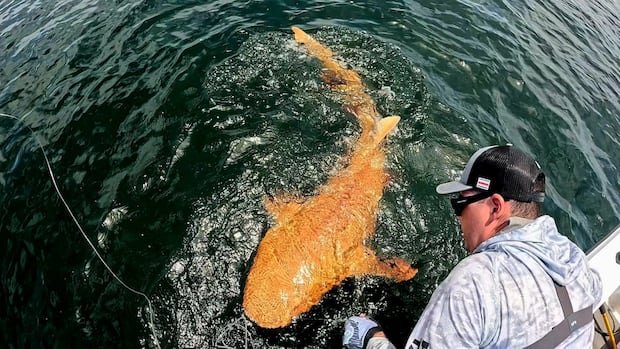Marine biologist Daniel Arauz Naranjo, known for his extensive experience with various shark species, recently encountered a remarkable sight – a nurse shark sporting a vibrant orange hue akin to a Creamsicle. The footage and images of this uncommonly colored shark, captured in the shallow waters off Costa Rica, left Naranjo astounded and intrigued.
Co-authoring a scientific paper on the subject, Naranjo and his team propose that the shark’s striking coloration results from a rare combination of genetic mutations. Published in the Marine Biodiversity journal, their findings have sparked curiosity about whether this shark is a solitary spectacle or if other uniquely colored specimens roam the Caribbean coast.
Despite his eagerness to observe the orange shark firsthand, Naranjo has yet to encounter it in person. The visuals of the shark were provided by a group of sports fishermen from Costa Rica who serendipitously reeled in the mysterious creature last August. Following a catch-and-release practice, the fishermen documented the shark’s appearance and promptly released it back into the ocean, later sharing their discovery with local researchers.
Nurse sharks typically exhibit shades of tan to dark brown and are classified as a vulnerable species by the International Union for Conservation of Nature due to threats like climate change, pollution, and overfishing. These nocturnal creatures inhabit warm, shallow waters, feeding on crustaceans, mollusks, and stingrays while seeking refuge in caves during the day.
Investigating the genetic underpinnings of the orange shark’s coloration, Naranjo and his team uncovered two rare conditions – albinism and xanthism. Albinism, characterized by a lack of melanin, is uncommon but not unheard of in sharks, while xanthism, causing animals to appear yellow or golden, is unprecedented in shark species. The convergence of these conditions likely accentuates the shark’s vibrant orange appearance.
James Sulikowski, a shark expert unaffiliated with the study, commended the research’s robust conclusions and expressed fascination with the unique shark’s coloration. Reflecting on the shark’s survival with such conspicuous coloration, Naranjo and his colleagues ponder the factors facilitating its adaptation in the oceanic environment, emphasizing the mystery surrounding this remarkable specimen.
The ongoing query revolves around the rarity of the orange shark and the potential existence of similar individuals. Naranjo highlights the natural and environmental triggers that could induce such genetic mutations, underscoring the need for further exploration. Despite the uncertainty, Naranjo remains hopeful, staying connected with the fishermen in hopes of encountering another orange shark firsthand.
The allure of this enigmatic creature continues to captivate researchers and enthusiasts alike, highlighting the marvels of marine biodiversity and the enduring mysteries within the oceanic realm.

